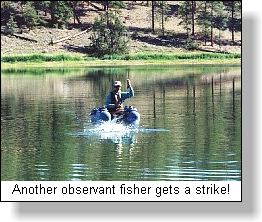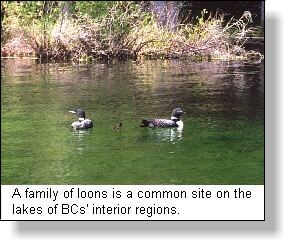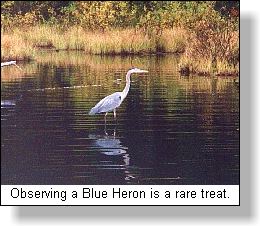
The Observant Flyfisher
article and photos by Gordon Honey
Other than fly fishing's rule #1: the
fly must be in or on the water to catch fish, one of
the most important tips to remember is to be observant.
This is where the new or intermediate angler often misses
the boat, or more appropriately the fish! The observant
angler will usually have greater success simply because
they will put themselves in areas of greater activity and
will present the correct fly at the proper depth. For
this to happen you must know what to be looking for.
 When you arrive at the lake, unload
your boat, etc., but before setting out, get to higher
ground if possible, and take a good look around. If there
is a heavy concentration of boats at one end or another
this is your first clue as to where the action might be.
Check the shoreline carefully, rocks and shore debris
will tell if there is a dragonfly or damselfly migration. Check for shrimp, so you are not guessing at the proper color.
Also, look for pupal shucks, evidence of a chironomid or caddis hatch
While on the water is also critical to
be attentive. As you approach the area you intend to
fish, use your Polaroid glasses to scan the shoals for
fish, then attempt to determine the depth of water they
are in. Check the surface of the water, are there
chironomids coming off? If so capture an adult and
determine the size and colour, this will allow you to
chose the appropriate corresponding pupae. If you do not
see any surface clues, watch for bird activities, they
will tell where the hatch is taking place. Don't forget
to observe subsurface activities; here you are looking
for damsels and leeches. If you see damsels in good numbers, capture
one with your aquarium net and examine it for the correct
colour and size (key components for presenting a fly with
success).
 If
you discover that there is no real evidence of either
fish or bug movement, begin with a full sink or sinktip
at the drop off until things begin to happen. Never stop
looking around. It does not make sense staying where you
are if you see fish moving in a different area, always
move to cover active fish! If
you discover that there is no real evidence of either
fish or bug movement, begin with a full sink or sinktip
at the drop off until things begin to happen. Never stop
looking around. It does not make sense staying where you
are if you see fish moving in a different area, always
move to cover active fish!
Simply because you had a great day at
one specific bay or shoal the day before does not
guarantee that they will still be there the following
day. Always take time to scan the lake as you fish. A
small pair of binoculars is a great tool to have in your
bag, also a small aquarium dip net to capture bugs. Train
yourself to be observant and your productivity will
increase, but more importantly your appreciation for your
surrounding environment will be greatly enhanced and
therefore your day on the water that much more enjoyable.
Jack Shaw told me a great story about
being observant; years ago he was fishing Salmon Lake
with his old friend Hebe Smith. They had been doing well
on floating lines and nymphs and then things slowed down
considerably. But soon Hebe began hooking fish again.
When asked about his success, Hebe replied that he had
noticed an Osprey working the
same shoal they were fishing and had switched to a
sinking line and immediate success. The fish, to avoid
the Osprey had moved to deeper water, his success was due
directly to being observant.
Heber Smith, another Kamloops pioneer Fly
Fisher. Hebe grew up on Vancouver
Island at Campbell River, where
his father, better known as Cougar Smith, was a
government cougar hunter. Hebe guided at Campbell during
it's hey day and quickly became known as one of the
premier guides. Due to an asthmatic condition Hebe moved
to the interior of the province in the late 30's His
friend Bill Nation had recently passed away and Hebe
moved to Paul Lake to take over
Bill's guide list and guided at Paul for a number of
years. Roderick Haig-Brown in his book Western Angler
quoted Hebe's observations on Paul Lake from a letter
Hebe had written him in June of 1941 (Haig-Brown had
lived with the Smith family when he first arrived in
Canada). Marriage and a family required a more stable
career so the guide days were over and Hebe began working
at Syd Smith, it was here that he and Jack Shaw, also an
employee, became close friends.
 Fishing,
as a profession, never left Hebes' future plans. In the
Late 50's he established the Heffley Lake Fish Camp,
successfully operating this camp until he sold it and
purchased Salmon Lake Resort, in 1964. His son Jamie
continued to operate the resort following Hebe's
retirement in 1975. When talking to Jamie for details on
his Dad's life I asked Jamie for one thing that stood out
as a memory of Hebe, Jamie replied that in December of
1975 Hebe returned to the Thompson
River which he so dearly loved
but had not fished for at least 15 years, and took two
beautiful Steelhead. Hebe passed
away two days later. Fishing,
as a profession, never left Hebes' future plans. In the
Late 50's he established the Heffley Lake Fish Camp,
successfully operating this camp until he sold it and
purchased Salmon Lake Resort, in 1964. His son Jamie
continued to operate the resort following Hebe's
retirement in 1975. When talking to Jamie for details on
his Dad's life I asked Jamie for one thing that stood out
as a memory of Hebe, Jamie replied that in December of
1975 Hebe returned to the Thompson
River which he so dearly loved
but had not fished for at least 15 years, and took two
beautiful Steelhead. Hebe passed
away two days later.
Heber Smith, great teacher, innovative
fly tier, top guide, fish camp pioneer and an observant
angler.
Gordon Honey gordon@flyfishingservices.com
| 




 If
you discover that there is no real evidence of either
fish or bug movement, begin with a full sink or sinktip
at the drop off until things begin to happen. Never stop
looking around. It does not make sense staying where you
are if you see fish moving in a different area, always
move to cover active fish!
If
you discover that there is no real evidence of either
fish or bug movement, begin with a full sink or sinktip
at the drop off until things begin to happen. Never stop
looking around. It does not make sense staying where you
are if you see fish moving in a different area, always
move to cover active fish! Fishing,
as a profession, never left Hebes' future plans. In the
Late 50's he established the Heffley Lake Fish Camp,
successfully operating this camp until he sold it and
purchased Salmon Lake Resort, in 1964. His son Jamie
continued to operate the resort following Hebe's
retirement in 1975. When talking to Jamie for details on
his Dad's life I asked Jamie for one thing that stood out
as a memory of Hebe, Jamie replied that in December of
1975 Hebe returned to the
Fishing,
as a profession, never left Hebes' future plans. In the
Late 50's he established the Heffley Lake Fish Camp,
successfully operating this camp until he sold it and
purchased Salmon Lake Resort, in 1964. His son Jamie
continued to operate the resort following Hebe's
retirement in 1975. When talking to Jamie for details on
his Dad's life I asked Jamie for one thing that stood out
as a memory of Hebe, Jamie replied that in December of
1975 Hebe returned to the